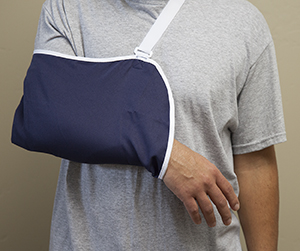After repair of your shoulder joint, you may go home the same day of your surgery. Or you may spend 24 hours in the hospital. Take care of your shoulder while it’s healing and follow all instructions you are given. Full healing often takes 3 to 4 months.
In the hospital
Here is what to expect in the hospital after surgery:
-
After your surgery, your incision or incisions will be closed with stitches, staples, or surgical tape. Your shoulder is covered with a dressing.
-
Your arm will be put in a sling or a brace to keep it from moving (immobilized).
At home
Here is what to expect at home after surgery:
-
Wear your sling or brace at all times, except when bathing or changing clothes. When your arm is out of the immobilizer, keep it at your side.
-
You may need to wear your sling or brace for 3 to 4 weeks.
-
Don't get your bandages or the incision(s) wet. Your surgeon may let you change your bandages after 2 or 3 days. Replace the bandages with a clean gauze dressing. Do not touch your incision.
-
Take your pain medicines as prescribed. If the medicines don’t control the pain to a tolerable level, call your healthcare provider.
-
Use ice on your shoulder, as instructed. Ice your shoulder for no more than 15 minutes at a time.
-
See your healthcare provider for an appointment 7 to 10 days after surgery. During this appointment, your stitches or staples may be removed, if you have them.
-
You will continue to have follow-up visits until your shoulder is healed. Keep these appointments to help make sure that your shoulder heals well.
-
Don't drive until you are no longer taking prescription pain medicines and your healthcare provider says it’s OK. Driving may be restricted for several weeks after surgery.
Rehabilitation
After surgery, you will be given exercises to do. You will be instructed to start certain range-of-motion exercises right after surgery. After the sling is taken off, you will be given other exercises to help with the flexibility and strength of your shoulder and arm. In many cases, you will be referred to a physical therapist for rehab.
When to call your healthcare provider
Call your healthcare provider right away if:
-
You have an increase in pain or swelling
-
Your arm tingles or feels numb
-
You have a fever of 100.4°F (38°C) or higher, or as advised by your provider
-
You have chills
-
Your shoulder bleeds a lot or fluid drains from the incision
Featured in


